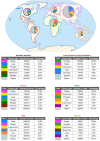Cancer survivorship in low- and middle-income countries: challenges, needs, and emerging support strategies
- PMID: 40740385
- PMCID: PMC12307438
- DOI: 10.3389/fpubh.2025.1601483
Cancer survivorship in low- and middle-income countries: challenges, needs, and emerging support strategies
Abstract
Cancer survivorship has become a critical global health issue, with survival rates on the rise in both high-income countries (HICs) and low- and middle-income countries (LMICs). Cancer survivors, encompassing individuals from diagnosis onward, face unique and complex health challenges that necessitate tailored care. In HICs, survival rates have increased due to advances in diagnosis and treatment, prompting robust survivorship programs addressing late effects and long-term quality of life. In LMICs, however, disparities in healthcare access, infrastructure, and support systems hinder comparable progress in survivorship care, particularly outside urban areas. LMIC survivors often contend with financial barriers, limited access to follow-up care, and significant psychosocial and rehabilitative gaps. Specialized survivorship centers are rare, and resources for addressing late effects are constrained, impacting survivors' long-term wellbeing. Emerging studies, primarily from middle-income nations, identify late effects such as endocrine and metabolic disorders, though robust, comprehensive data remain scarce. For childhood cancer survivors, late effects like chronic viral infections and cognitive impairments are documented, yet systematic follow-up remains limited. To bridge these gaps, LMICs require innovative care models, such as non-profit partnerships and community-based interventions, to meet the complex needs of survivors. In Brazil, we've highlighted successful programs including the Mais Médicos program for increased care capacity and DATA-SUS as a model registry. This review synthesizes available literature on cancer survivorship in LMICs, evaluating challenges and successful practices across diverse regions. Addressing these needs is crucial for improving survivorship care, particularly in regions where socioeconomic disparities amplify the challenges of post-cancer recovery.
Keywords: cancer survivorship; health disparities; late effects; low-and middle-income countries (LMICs); quality of life.
Copyright © 2025 dos Anjos, Machado, de Barros, de Andrade, Maciel and Cunha.
Conflict of interest statement
The authors declare that the research was conducted in the absence of any commercial or financial relationships that could be construed as a potential conflict of interest.
Figures


Similar articles
-
Financial arrangements for health systems in low-income countries: an overview of systematic reviews.Cochrane Database Syst Rev. 2017 Sep 11;9(9):CD011084. doi: 10.1002/14651858.CD011084.pub2. Cochrane Database Syst Rev. 2017. PMID: 28891235 Free PMC article.
-
Survivorship Needs in Patients With Head and Neck Cancer in Regional, Rural and Remote Areas: A Systematic Review.Psychooncology. 2024 Sep;33(9):e9311. doi: 10.1002/pon.9311. Psychooncology. 2024. PMID: 39285611
-
Home-based multidimensional survivorship programmes for breast cancer survivors.Cochrane Database Syst Rev. 2017 Aug 24;8(8):CD011152. doi: 10.1002/14651858.CD011152.pub2. Cochrane Database Syst Rev. 2017. PMID: 28836379 Free PMC article.
-
Hail Lifestyle Medicine consensus position statement as a medical specialty: Middle Eastern perspective.Front Public Health. 2025 Jun 20;13:1455871. doi: 10.3389/fpubh.2025.1455871. eCollection 2025. Front Public Health. 2025. PMID: 40620567 Free PMC article.
-
Short-Term Memory Impairment.2024 Jun 8. In: StatPearls [Internet]. Treasure Island (FL): StatPearls Publishing; 2025 Jan–. 2024 Jun 8. In: StatPearls [Internet]. Treasure Island (FL): StatPearls Publishing; 2025 Jan–. PMID: 31424720 Free Books & Documents.
References
-
- Vázquez ML, Vargas I, Rubio-Valera M, Aznar-Lou I, Eguiguren P, Mogollón-Pérez AS, et al. Improving equity in access to early diagnosis of cancer in different healthcare systems of Latin America: protocol for the EquityCancer-LA implementation-effectiveness hybrid study. BMJ Open. (2022) 12:e067439. 10.1136/bmjopen-2022-067439 - DOI - PMC - PubMed
Publication types
MeSH terms
LinkOut - more resources
Full Text Sources
Medical

